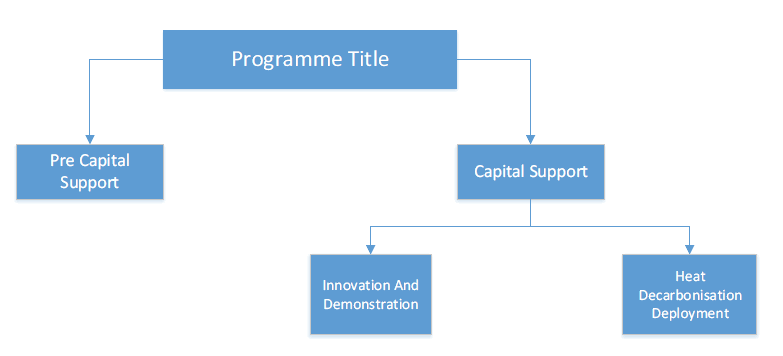Low Carbon Infrastructure Transition Programme (LCITP): call for evidence
This Call for Evidence seeks input on actions to modify and enhance the range of support mechanisms currently provided by Scottish Government through the Low Carbon Infrastructure Transition Programme (LCITP) for development and delivery of large-scale low and zero carbon heat in buildings projects.
Chapter 4 Proposed Programme Priorities and Structure
4.1 The future programme will deliver outcomes-based infrastructure investment and will complement the up-scaled support provided through our existing domestic, business, community and public sector programmes as detailed in the draft Heat in Buildings Strategy.

The proposed strategic priorities are:
1. Developing Project Pipeline Through Pre-Capital Support
Enhance existing LCITP pre-capital support for heat decarbonisation projects to facilitate building a pipeline to be delivered over the next decade and beyond including development and provision of:
- solution development;
- business cases;
- financial expertise;
- technical expertise;
- legal expertise;
- project management;
- procurement expertise.
As set out in the draft Heat in Buildings Strategy, the Heat Networks Partnership will be re-established to act as a mechanism for supporting the development of a pipeline of projects across Scotland, co-ordinating support across the public sector, identifying and nurturing opportunities for new heat networks and considering the options for decarbonising existing fossil fuel powered networks. This Partnership will form part of the new programme's pre-capital support offer with potential to widen the scope to include more low and zero carbon heat projects.
2. Supporting at Scale Heat Decarbonisation
Accelerate deployment and rollout of heat technologies already tested through the LCITP and other programmes through provision of capital co-funding, with focus on the Strategic Technologies below identified in the draft Heat in Buildings Strategy where there is a demonstrable project funding gap.
| Deployment of Green Heat networks |
|
|---|---|
| Heat Pump Deployment |
|
During 2020, we launched the Social Housing Net Zero Heat Fund, delivered via the LCITP, to support social housing landlords across Scotland to deploy low carbon heat and to contribute towards our heat decarbonisation and fuel poverty objectives. As almost a quarter of Scotland's domestic dwellings are social housing, we will continue this fund for the next five years to deliver demonstrable progress with decarbonising social housing stock and we will also consider how to link this financial support for zero emissions heating with our domestic energy efficiency programmes. Our experience with the Social Housing Net Zero Heat Fund demonstrates that the learning and expertise of the LCITP approach can be effectively deployed to deliver at scale investment in heat infrastructure and we will seek to build on this in the successor programme.
3. Demonstrating Innovative Low and Zero Carbon Heat Infrastructure Projects
Continuing co-funded capital support for innovative demonstrator projects for heat decarbonisation in buildings . This will focus on large scale multiple building projects that demonstrate partnership delivery, new business models and utilise individual technologies or integrated systems that are proven but have not yet reached commercial viability (Technology Readiness Levels 7-9) and therefore face challenges in securing investment. This will include, heat recovery, geothermal, thermal storage and hydrogen for heating buildings.
4. Facilitating Place Based Decarbonisation
A step change in our approach to decarbonisation is required, one that takes a more strategic overview, covering distinct geographical areas and recognising specific challenges in city, urban, rural and island communities. This will involve developing partnership arrangements at delivery level between local authorities, the public sector, the private sector, energy network companies and local communities. Projects seeking funding must look at developing partnerships and aggregating demand across specific locations and geographies and should cover the following elements: awareness raising at a local level and technology deployment across domestic and non-domestic buildings.
5. Support Delivery of Local Heat and Energy Efficiency Strategies
At the heart of a place based, locally-led and tailored approach will be Local Heat and Energy Efficiency Strategies (LHEES). Once in place these local strategies will provide a framework for taking an area-based approach to heat and energy efficiency planning and delivery.
LHEES will set out the long-term plan for decarbonising heat in buildings and improving their energy efficiency across an entire local authority area. The strategies will:
- set out how each segment of the building stock needs to change to meet national objectives, including achieving net zero GHG emissions in the building sector, and the removal of poor energy efficiency as a driver of fuel poverty;
- identify heat decarbonisation zones, setting out the primary measures for reducing emissions for an area; and
- prioritise areas for delivery, against national and local priorities.
LHEES will form the basis for local public engagement and involvement in decision making at the local level and will be developed through extensive engagement with local communities. We want Local Heat and Energy efficiency Strategies and Delivery Plans to be in place for all local authority areas by the end of 2023. The LCITP successor programme will have a role in providing delivery support.

4.2 Eligible projects will require to meet the minimum criteria below:
- the potential to deliver a significant reduction of greenhouse gas emissions (MtCO₂e) and energy consumption;
- the ability to secure other sources of funding/finance that make a contribution towards the cost of final delivery costs of the project;
- the potential to have a positive and significant economic and social impact on Scotland;
- sets out clearly the requirement for and value added from programme support;
- the ability to demonstrate a contribution to the strategic aims of heat decarbonisation activity.
Questions
6. Do you agree with the priorities outlined above? Please explain your views.
7. Are there further specific gaps in project support that should be filled? Please explain your views
8. What types of pre-capital support would help to support low and zero carbon heat projects? Please explain your views.
9. Do you support the widening of the scope of the Heat Network Partnership to cover other low and zero carbon heat projects? Please explain your views.
10. How can the programme best support delivery of LHEES from 2023? Please explain your views.
11. How can the programme best support place based integrated partnership delivery? Please explain your views.
Low Carbon Infrastructure Transition Programme Case Study 3
Stirling Renewable Heat Project
Stirling Council and Scottish Water Horizons came together to create, develop and deliver the Stirling Renewable Heat Project. The project brings low cost, low-carbon heat through a district heating network, delivering a range of significant environmental and economic benefits.
The Stirling Renewable Heat Project, which received £2 million support from LCITP, uses an existing aerobic digestion plant, with a combined heat and power plant and a waste water heat pump. This is the first time such technologies have been used in conjunction in Scotland.
Heat from this scheme is distributed in the Forthside area of Stirling to the Peak Leisure Centre, Forthbank Stadium, St Modan's High School, the Robertson Trust Barracks Development, Moray house and Jubilee House.
Contact
Email: LCITP@gov.scot
There is a problem
Thanks for your feedback